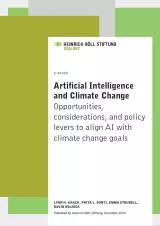Artificial Intelligence and Climate Change
With the increasing deployment of artificial intelligence (AI) technologies across society, it is important to understand in which ways AI may accelerate or impede climate progress, and how various stakeholders can guide those developments. On the one hand, AI can facilitate climate change mitigation and adaptation strategies within a variety of sectors, such as energy, manufacturing, agriculture, forestry, and disaster management. On the other hand, AI can also contribute to rising greenhouse gas emissions through applications that benefit high-emitting sectors or drive increases in consumer demand, as well as via energy use associated with AI itself. Here, we provide a brief overview of AI’s multi-faceted relationship with climate change, and recommend policy levers to align the use of AI with climate change mitigation and adaptation pathways.
Product details
Table of contents
Foreword
Summary
1. What is AI?
2. Artificial intelligence and climate change
AI applications for climate change mitigation and adaptation
AI applications increasing emissions or with uncertain impact
Energy use of Al
3. Policy levers
4. Policy-relevant considerations
5. Conclusion
Recommended readings
References
